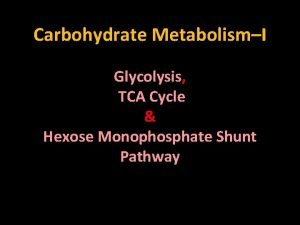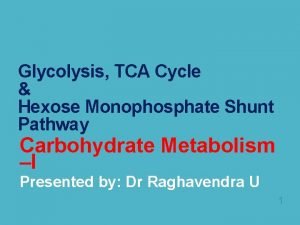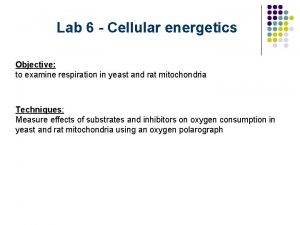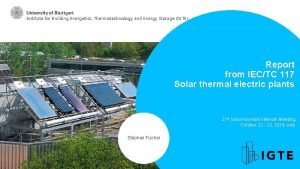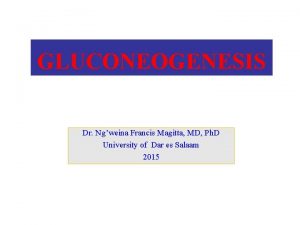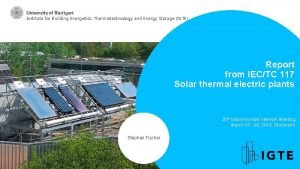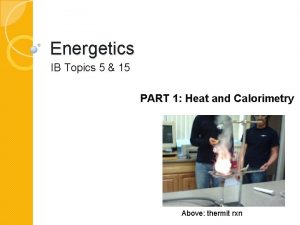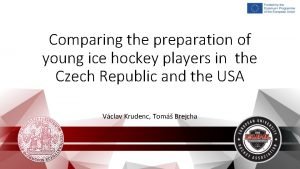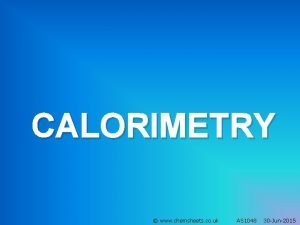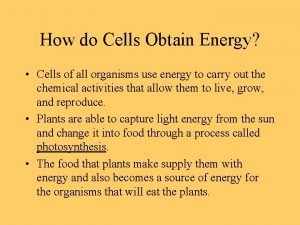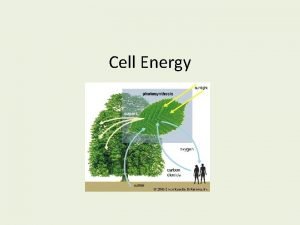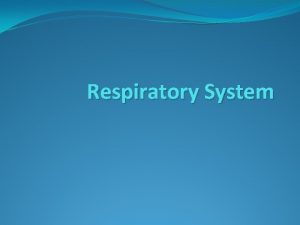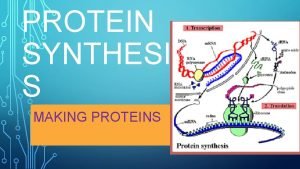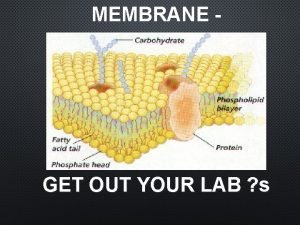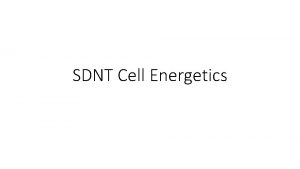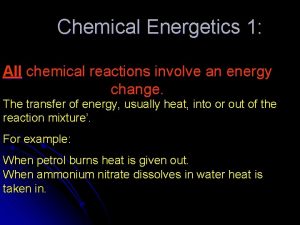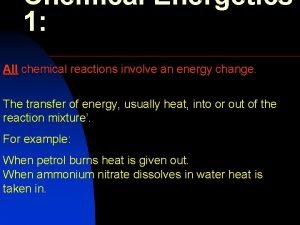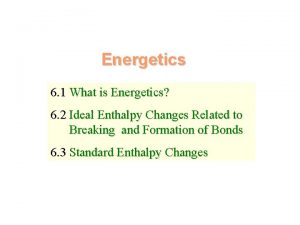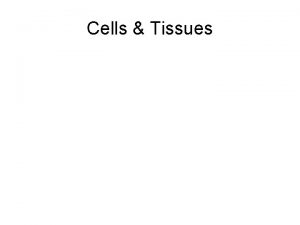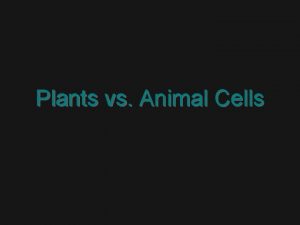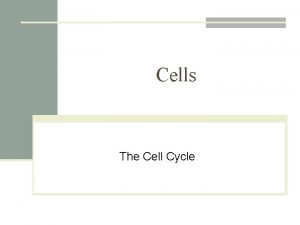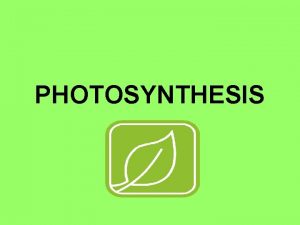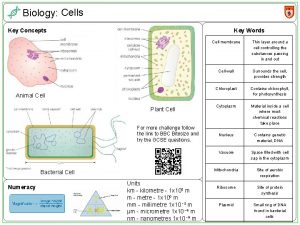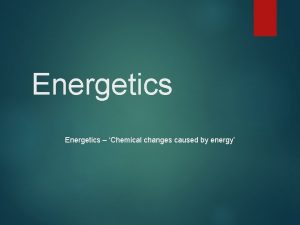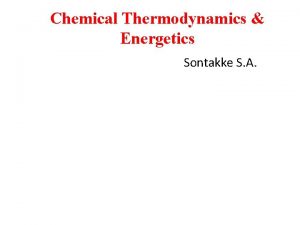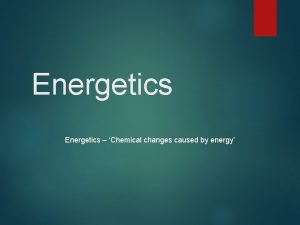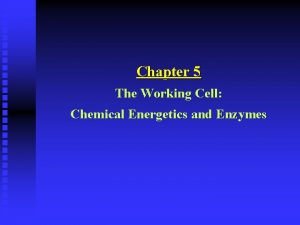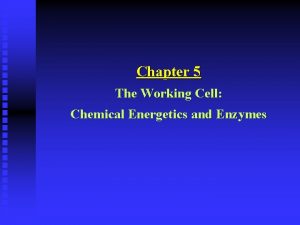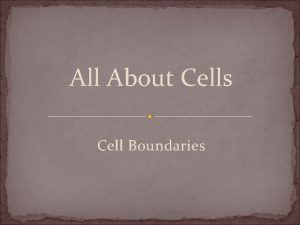Cell Energetics Key Concepts All cells need chemical



















- Slides: 19

Cell Energetics

Key Concepts • All cells need chemical energy • Photosynthesis requires a series of chemical reactions • The overall process of photosynthesis produces sugars that store chemical energy • The overall process of cellular respiration converts sugar into ATP using oxygen • Cell respiration is an aerobic process with two main stages • Fermentation allows the production of a small amount of ATP without oxygen

The chemical energy used for most cell processes is carried by ATP. • Molecules in food store chemical energy in their bonds. Starch molecule Glucose molecule

• ATP transfers energy from the breakdown of food molecules to cell functions. – Energy is released when a phosphate group is removed. – ADP is changed into ATP when a phosphate group is added. phosphate removed

• Fats store the most energy. – 80 percent of the energy in your body – about 146 ATP from a triglyceride • Proteins are least likely to be broken down to make ATP. – amino acids not usually needed for energy – about the same amount of energy as a carbohydrate

A few types of organisms do not need sunlight and photosynthesis as a source of energy. • Chemosynthesis - chemical energy is used to build carbon -based molecules. – similar to photosynthesis – uses chemical energy instead of light energy

Photosynthetic organisms are producers. • Producers make their own source of chemical energy. • Plants use photosynthesis and are producers. • Photosynthesis captures energy from sunlight to make sugars.

• Chlorophyll is a molecule that absorbs light energy. • In plants, chlorophyll is found in organelles called chloroplasts. • Photosynthesis in plants occurs in chloroplats • Grana (thylakoids) • Stroma chloroplast leaf cell leaf

• The light-dependent reactions capture energy from sunlight. – – take place in thylakoids water and sunlight are needed chlorophyll absorbs energy is transferred along thylakoid membrane then to light-independent reactions – oxygen is released

• The light-independent reactions make sugars. – take place in stroma – needs carbon dioxide from atmosphere – use energy to build a sugar in a cycle of chemical reactions

• The equation for the overall process is: 6 CO 2 + 6 H 2 O + E C 6 H 12 O 6 + 6 O 2 granum (stack of thylakoids) 1 chloroplast su nli gh t 6 H 2 O thylakoid 6 CO 2 3 6 O 2 2 energy stroma (fluid outside thylakoids) 1 six-carbon sugar 4 C 6 H 12 O 6

Cellular respiration makes ATP by breaking down sugars. • Cellular respiration is aerobic, or requires oxygen. • Aerobic stages take place in mitochondria. mitochondrion animal cell

• Glycolysis must take place first. – – anaerobic process (does not require oxygen) takes place in cytoplasm splits glucose into two three-carbon molecules produces two ATP molecules

Cellular respiration is like a mirror image of photosynthesis. – takes place in mitochondrial matrix – breaks down three-carbon molecules from glycolysis – makes a small amount of ATP – releases carbon dioxide – transfers energy-carrying molecules Krebs Cycle 1 mitochondrion ATP matrix (area enclosed and by inner membrane) 6 CO 2 energy 3 energy from glycolysis and 6 O 2 2 inner membrane ATP and 6 H 2 O 4

• The equation for the overall process is: C 6 H 12 O 6 + 6 O 2 6 CO 2 + 6 H 2 O + E • The reactants in photosynthesis are the same as the products of cellular respiration.

Fermentation allows glycolysis to continue. • Fermentation allows glycolysis to continue making ATP when oxygen is unavailable. • Fermentation is an anaerobic process. – occurs when oxygen is not available for cellular respiration – does not produce ATP

• Fermentation allows glycolysis to continue making ATP when oxygen is unavailable. • Lactic acid fermentation occurs in muscle cells.

Fermentation and its products are important in several ways. • Alcoholic fermentation is similar to lactic acid fermentation. – glycolysis splits glucose and the products enter fermentation – energy from NADH is used to split pyruvate into an alcohol and carbon dioxide

• Fermentation is used in food production. – yogurt – cheese – bread
 Hmp significance
Hmp significance Hcoh
Hcoh Main function of tca cycle
Main function of tca cycle Sodium azide electron transport chain
Sodium azide electron transport chain Energetics power tower 180
Energetics power tower 180 Gluconeogenesis from lactate
Gluconeogenesis from lactate Building energetics
Building energetics Ib energetics
Ib energetics Energetics janesville
Energetics janesville Chemsheets energetics introduction answers
Chemsheets energetics introduction answers How do cells obtain the energy they need
How do cells obtain the energy they need Why do cells need energy
Why do cells need energy What compounds do cells need
What compounds do cells need Couter
Couter Why do we need cells
Why do we need cells What cells need isotonic solutions to be at homeostasis
What cells need isotonic solutions to be at homeostasis Onodi cells and haller cells
Onodi cells and haller cells Alpha intercalated cells
Alpha intercalated cells Thyroid parafollicular cells
Thyroid parafollicular cells How are mitosis and meiosis similar
How are mitosis and meiosis similar
